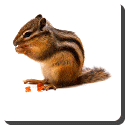 Chipmunk — Chipmunk is the common name for any small squirrel-like rodent species of the genus Tamias in the family Sciuridae. Around 25 species fall under this name, mainly in North America, although one species is native to Eurasia.
Chipmunk — Chipmunk is the common name for any small squirrel-like rodent species of the genus Tamias in the family Sciuridae. Around 25 species fall under this name, mainly in North America, although one species is native to Eurasia.
Eastern chipmunks mate in early spring and again in early summer, producing litters of four or five young twice each year. Western chipmunks only breed once a year. The young emerge from the burrow after about six weeks and strike out on their own within the next two weeks.
Though they are commonly depicted with their paws up to the mouth, eating peanuts, or more famously their cheeks bulging out on either side, chipmunks eat a variety of foods. Their omnivorous diet consists of grain, nuts, birds’ eggs, fungi, worms, and insects. At the beginning of autumn, many species of chipmunk begin to stockpile these goods in their burrows, for winter. Other species make multiple small caches of food. These two kinds of behavior are called larder hoarding and scatter hoarding. Larder hoarders usually live in their nests until spring.
These small squirrels fulfill several important functions in forest ecosystems. Their activities harvesting and hoarding tree seeds play a crucial role in seedling establishment. They consume many different kinds of fungi, including those involved in symbiotic mycorrhizal associations with trees, and are an important vector for dispersal of the spores of subterranean sporocarps (truffles) which have co-evolved with these and other mycophagous mammals and thus lost the ability to disperse their spores through the air.
 Kids Portal For Parents India Kids Network
Kids Portal For Parents India Kids Network






